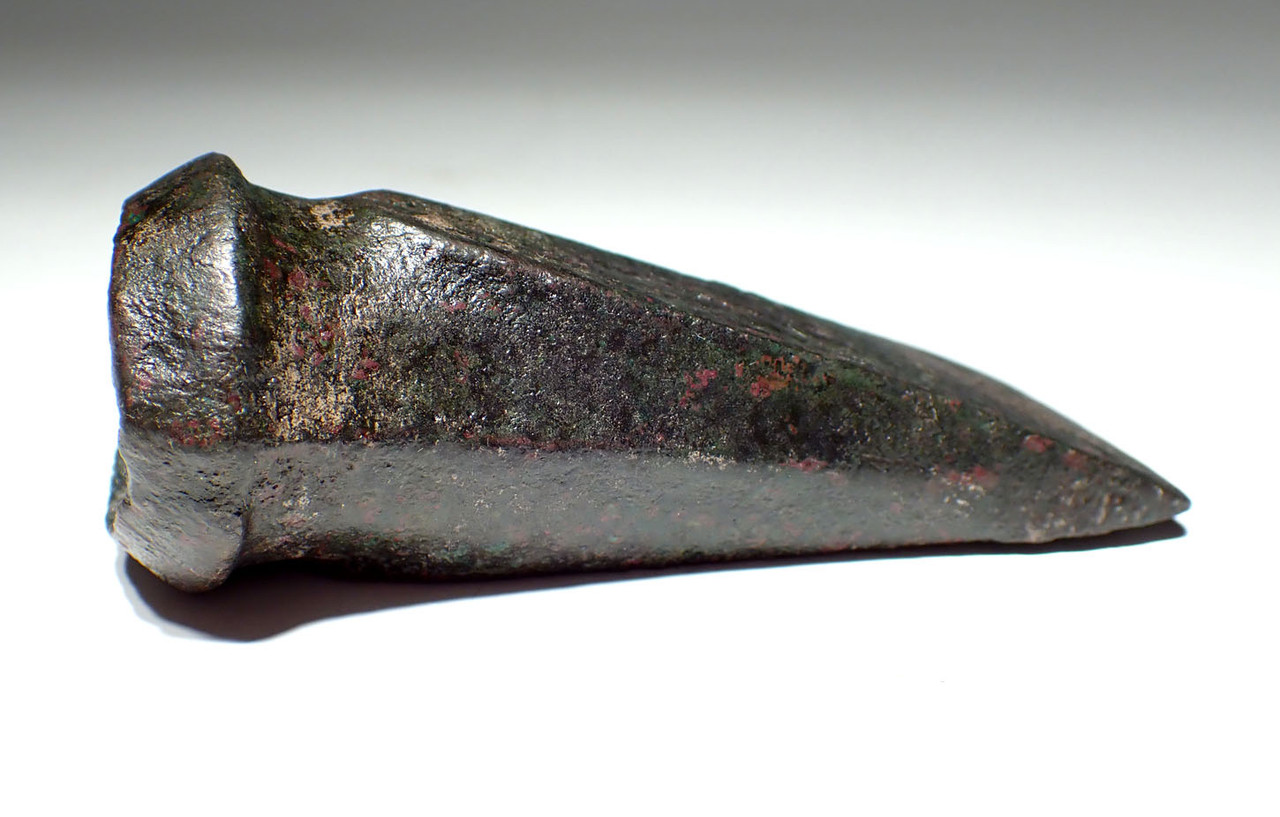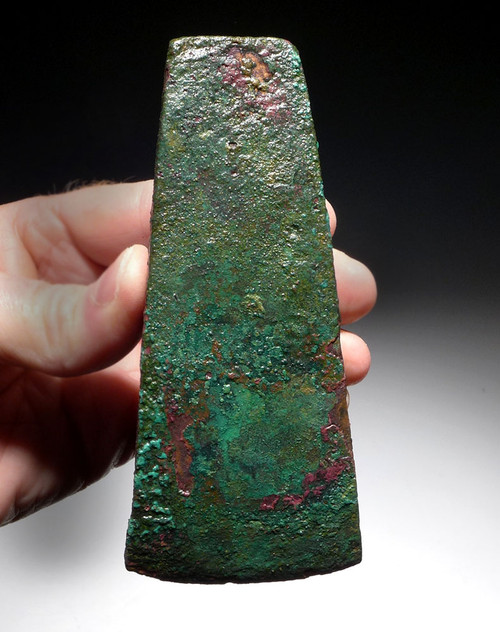Product Description
SEE MORE ANCIENT EUROPEAN BRONZE AGE ARTIFACTS
This superb ancient bronze socketed axe was found in Northwest France, and comes from the Late Bronze Age of Atlantic Europe, dating to 1000 BC to 900 BC. It is complete with a fascinating story. There is an ancient crack in the socket mouth opening which is how this axe would have come off its wooden shaft handle. Many of these ancient socketed axes had a loop cast into the design and this loop in the bronze was used to tie a cord from the axe head to the wooden handle to prevent loss in case of axe failure. In this case, no such loop was incorporated into the design which would have prevented the axe from being lost if it had. Examination of the interior of the socket shows ancient defects in how it was made caused by casting porosity. This is what would have originally caused the axe to fail as the porosity caused a weak point in the very region of the axe where strength is needed. So, a modern-day lesson can be had in this ancient weapon - workmanship and intelligent design features will always prevail, all others will fail!
Aesthetic dark green ancient encrustations are intact on all bronze surfaces, a testament to its age and authenticity. The socketed axe was a common axe design of the Late Bronze Age throughout Europe. These axes were important in utilitarian use and warfare. They also served to represent wealth and possible trade currency. This type of axe would have been mounted on a long wooden handle with a L-shaped end. A bronze wedge nail would have been driven into this hole to affix the axe to the handle shaft. In this early period, bronze was very expensive and highly valued. Only certain individuals would have possessed such a cherished tool. The diminutive size of this specimen would have also made it highly effective as a weapon since its small proportion would have been well suited for armor penetration and rapid swinging in combat if used as a weapon. From a former Dutch private collection formed in the 1980's. Cleaned and conserved in our on-site lab. A quality specimen!
HISTORY
The Atlantic Bronze Age is a cultural complex of the European Bronze Age period of approximately 1300–700 BC that includes different cultures in Portugal, Andalusia, Galicia, France, Britain, and Ireland and is marked by economic and cultural exchange that led to the high degree of cultural similarity exhibited by coastal communities, including the frequent use of stones as chevaux-de-frise, the establishment of cliff castles, or the domestic architecture sometimes characterized by the round houses. Commercial contacts extended from Sweden and Denmark to the Mediterranean. The period was defined by a number of distinct regional centres of metal production, unified by a regular maritime exchange of some of their products. The major centres were southern England and Ireland, north-western France, and western Iberia.
The European Bronze Age is characterized by bronze artifacts and the use of bronze implements. The regional Bronze Age succeeds the Neolithic and Copper Age and is followed by the Iron Age. It starts with the Aegean Bronze Age in 3200 BC and spans the entire 2nd millennium BC (including the Unetice culture, Ottomány culture, British Bronze Age, Argaric culture, Nordic Bronze Age, Tumulus culture, Nuragic culture, Terramare culture, Urnfield culture and Lusatian culture), lasting until c. 800 BC in central Europe.
Arsenical bronze was produced in some areas from the 4th millennium BC onwards, prior to the introduction of tin bronze. Tin bronze foil had already been produced in southeastern Europe on a small scale in the Chalcolithic era, with examples from Pločnik in Serbia dated to c. 4650 BC, as well as 14 other artefacts from Bulgaria and Serbia dated to before 4000 BC, showing that early tin bronze developed independently in Europe 1500 years before the first tin bronze alloys in the Near East. This bronze production lasted for c. 500 years in the Balkans but disappeared at the end of the 5th millennium, coinciding with the "collapse of large cultural complexes in north-eastern Bulgaria and Thrace in the late fifth millennium BC". Tin bronzes using cassiterite tin were subsequently reintroduced to the area some 1500 years later.
WARNING: There is an ALARMING number of fake and altered ancient artifacts on the market. As fine quality intact, original specimens become more scarce and techniques have become more sophisticated to fake these artifacts. We have personally handled numerous extremely well-done fakes with convincing patinas that could fool most people. The degree to which the fakers have been able to replicate patina to disguise their work requires an expert examination by highly experienced individuals. Like all rare collectibles, fakes plague the market. We subject every piece we offer to a full analysis, cleaning and conservation process in our on-site lab. How many dealers do this or have any experience in operating their own lab? The procedures we put each piece through are the same as we do for those specimens destined for museums and the same procedures as the best museums perform on their own collections. Deal only with sources that are extremely knowledgeable in forgeries or altered pieces and get a written guarantee of authenticity that has no conditions or expiration period. We include this guarantee in writing with every item we sell. All purchases should include from the dealer, a written guarantee of authenticity with unconditional and lifetime return policies regarding such guarantee.
 US DOLLAR
US DOLLAR
 EURO
EURO
 AUSTRALIAN DOLLAR
AUSTRALIAN DOLLAR
 CANADIAN DOLLAR
CANADIAN DOLLAR
 POUND STERLING
POUND STERLING


























